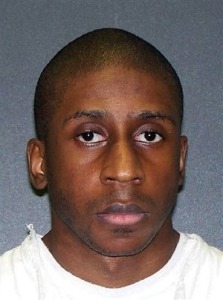Texas Revenge Done for White Woman's Murder: Legal Lynching of Black Man Executed in 'Death Belt' Capital
/ In photo, Mario Swain, another Black person put to death for killing a white victim. Blacks are 22 times more likely to be put to death when the victim is white and 81% of Executed Defendants had White Victims [MORE] even though Black people make up about half of all homicide victims. [MORE] Texas is one of the states of what is often called the "Death Belt" - the southern states that together account for over 90% of all executions carried out since 1976. These states overlap considerably with the southern states that had the highest incidence of extra-legal violence and killings during the Jim Crow era. See Southern Commission on the Study of Lynching, Lynchings and What They Mean 74 tbl. II (1931). From [HERE] A Black man described by a prosecutor as "a serial killer in training" was executed Thursday in Texas for a woman's slaying during a break-in at her home a decade ago.
In photo, Mario Swain, another Black person put to death for killing a white victim. Blacks are 22 times more likely to be put to death when the victim is white and 81% of Executed Defendants had White Victims [MORE] even though Black people make up about half of all homicide victims. [MORE] Texas is one of the states of what is often called the "Death Belt" - the southern states that together account for over 90% of all executions carried out since 1976. These states overlap considerably with the southern states that had the highest incidence of extra-legal violence and killings during the Jim Crow era. See Southern Commission on the Study of Lynching, Lynchings and What They Mean 74 tbl. II (1931). From [HERE] A Black man described by a prosecutor as "a serial killer in training" was executed Thursday in Texas for a woman's slaying during a break-in at her home a decade ago.
Mario Swain, 33, received a lethal injection for killing Lola Nixon at her home in East Texas' Longview two days after Christmas in 2002. When asked by a warden if he had a final statement before his punishment, the condemned prisoner shook his head, closed his eyes and took several barely audible breaths. Within a moment, all movement stopped. Swain was pronounced dead 30 minutes later, at 6:39 p.m. CST.
No family members or friends of Nixon were at the execution. Swain also had no relatives among the witnesses. Swain's attorney, James Volberding, said no late attempts were made in the courts to block the execution, the 13th this year in the nation's busiest capital punishment state.
The U.S. Supreme Court last month refused to review the case, and the Texas Court of Criminal Appeals last week rejected an appeal that contended a prison expert's testimony during the sentencing phase of Swain's 2003 capital murder trial was false and misleading.
Swain declined media interview requests as his execution date neared.
Evidence showed Swain threw the 46-year-old Nixon's body into the trunk of her BMW after killing her, drove to a remote area outside of the city about 120 miles east of Dallas and dumped it in the back seat of an abandoned car.
Nixon missed a dinner engagement with friends on the night she was slain. Her friends called police when they couldn't reach her the next day, and officers who went to her home found the back door jimmied.
Once inside, they saw blood throughout the house. A neighbor reported seeing an unfamiliar truck parked on the street the night before, and police tracked the vehicle to Swain.
He initially blamed friends for the burglary, then led police to Nixon's body. Authorities determined she'd been beaten with a tire iron, stabbed and strangled.
The tire iron was recovered from a trash container where Swain said he had thrown it. Evidence showed he used Nixon's credit cards and gave a piece of her stolen jewelry to a friend. Nixon's blood was found on Swain's clothing in the truck, along with her car keys and garage door opener.
According to evidence and testimony at trial, Swain gathered information about women he wanted to rob and then would attack them, forcing them to inhale the anesthetic halothane and hitting them over the head with a wrench or shooting them with a stun gun.
Lance Larison, a prosecutor at Swain's trial, described Swain as "a serial killer in training."
"A girlfriend told us he kept a list in notebooks of names and license plates of girls he would follow," Larison said. "I think he was working up to something."
It's not clear if Swain knew Nixon. She managed a Longview telephone call center where Swain once worked.
One of Swain's trial lawyers, Rick Hagan, said the evidence and vivid testimony from those who say Swain robbed and attacked them hindered the defense's efforts to convince jurors to spare Swain from the death penalty.
Larson said blood evidence in the case was "consistent with a struggle" inside Nixon's home, where she lived alone.
Deborah Hancock told the Longview News-Journal she and her husband were to have dinner with Nixon that Friday night after Christmas 2002. They stopped by Nixon's house with a carry-out package when she didn't arrive to eat with them. When their knocks went unanswered, they left the food at her front door.
"I can't believe it's been 10 years," Hancock said. "She was very outgoing and very direct, fun, lively. She was just one of a kind."
Swain's execution is to be followed by two more next week in Texas.








































































































































































































































































